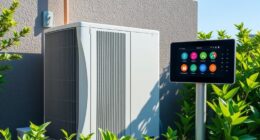Would you like to install a heat pump in your home and ensure that the process is efficient and successful? We are here to assist you!
In this article, we’ll share essential tips and step-by-step instructions on how to:
- Select the right heat pump
- Properly size and calculate the load
- Choose a suitable location
- Prepare the area for installation
We’ll also cover important considerations such as:
- Electrical requirements
- Refrigerant charging
- Thermostat setup
- Regular maintenance
Let’s get started on your journey to a comfortable and energy-efficient home!

Key Takeaways
- Consider specific heating and cooling needs
- Ensure proper sizing for optimal performance
- Consult with a professional HVAC technician
- Perform a detailed load calculation
Selecting the Right Heat Pump for Your Home
We should consider our specific heating and cooling needs when selecting the right heat pump for our home. Sizing considerations play a crucial role in determining the efficiency and effectiveness of a heat pump. It’s essential to choose a heat pump that’s sized correctly for our home to ensure optimal performance.
Oversized heat pumps may cycle on and off frequently, leading to energy inefficiency and increased wear and tear. On the other hand, an undersized heat pump will struggle to meet the heating and cooling demands of our home, resulting in poor comfort levels and higher energy bills. Therefore, it’s advisable to consult with a professional HVAC technician who can conduct a thorough evaluation of our home’s size, insulation, and other factors to determine the appropriate heat pump size.
Energy efficiency is another vital factor to consider when selecting a heat pump. Look for models with high Seasonal Energy Efficiency Ratio (SEER) and Heating Seasonal Performance Factor (HSPF) ratings, as they indicate the unit’s energy efficiency. Additionally, ENERGY STAR certified heat pumps meet strict energy efficiency guidelines set by the Environmental Protection Agency, ensuring significant energy savings and reduced environmental impact.
Proper Sizing and Load Calculation
To ensure optimal performance and efficiency, it’s important to properly size and calculate the load when installing a residential heat pump. Here are three essential tips for load calculation and heat pump sizing:

-
Perform a detailed load calculation: A load calculation takes into account factors such as the size of the home, insulation levels, windows, and climate to determine the heating and cooling needs. This helps determine the appropriate size of the heat pump for maximum efficiency.
-
Consider the Heating Seasonal Performance Factor (HSPF): HSPF is a measure of the heat pump’s efficiency during the heating season. Higher HSPF ratings indicate better energy efficiency. Choosing a heat pump with a suitable HSPF for your region will ensure optimal performance.
-
Consult with a professional HVAC contractor: Proper load calculation and heat pump sizing require expertise. It’s advisable to seek the assistance of a qualified HVAC contractor who can accurately assess your home’s needs and recommend the right heat pump size for your specific requirements.
Suitable Location for Installation
Where should we install the heat pump for optimal performance and efficiency?
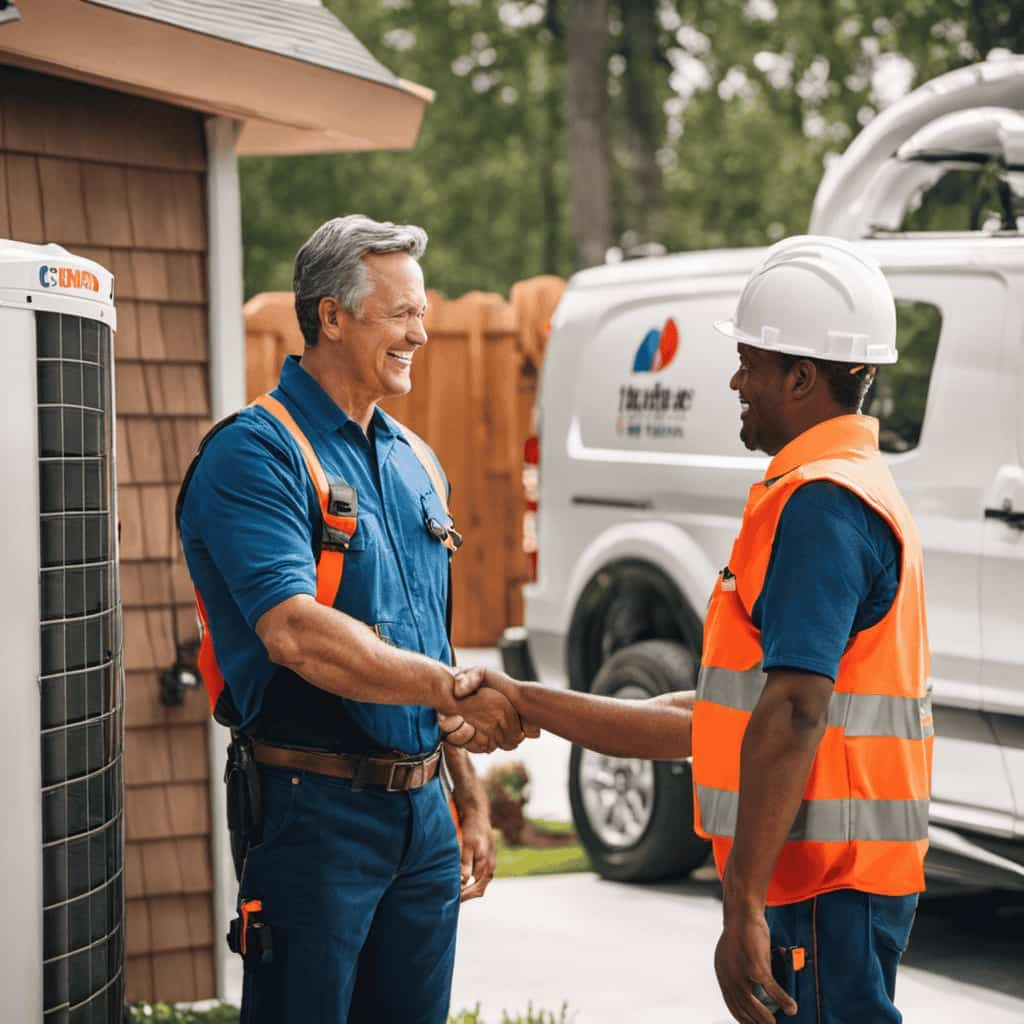
The suitable location selection is a crucial aspect of the installation process. To ensure the best results, it’s important to consider several factors.
First, the heat pump should be placed in an area with adequate airflow to allow for proper heat exchange. This means avoiding areas with obstructions or limited space.
Additionally, the location should be chosen with noise reduction in mind, as heat pumps can produce some level of noise during operation.
Furthermore, it’s important to consider the proximity to the indoor and outdoor units, as well as any potential obstacles that may impact the installation process.

Preparing the Area for Installation
Before proceeding with the installation of a residential heat pump, it’s crucial to prepare the area adequately. This involves clearing the surroundings to ensure there are no obstructions or debris that could interfere with the installation process or the functioning of the heat pump.
Additionally, proper ventilation requirements need to be considered to ensure optimal performance and efficiency of the heat pump system.
Clearing the Surroundings
We must prioritize the removal of any obstacles that may hinder the smooth installation process of the residential heat pump. Clearing the surroundings is crucial to ensure that the heat pump operates efficiently and effectively. Here are three essential steps to prepare the area for installation:
-
Remove any debris or clutter: Clear away leaves, branches, rocks, or any other objects that could obstruct the installation process. This will create a safe and accessible workspace for the technicians.
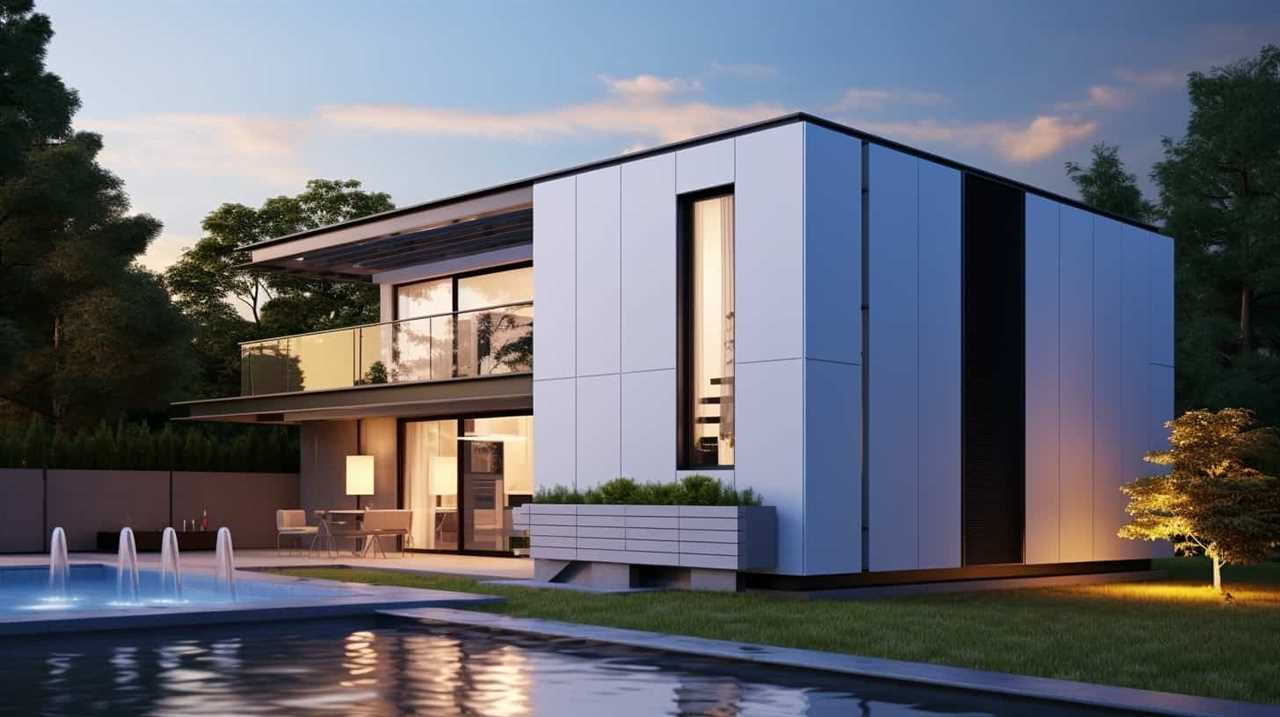
-
Trim vegetation: Trim any overgrown bushes, trees, or shrubs near the installation area. This ensures that the heat pump has proper airflow and prevents any potential damage caused by branches or leaves.
-
Level the ground: Ensure that the installation area is level and free from any slopes or uneven surfaces. This provides a stable foundation for the heat pump and helps prevent any issues with its operation.
Proper Ventilation Requirements
To ensure proper ventilation during the installation process, we should use the appropriate materials and follow the necessary guidelines. Ventilation standards play a crucial role in maintaining a safe and efficient heat pump system.
When preparing the area for installation, it’s important to consider ventilation system design. This involves selecting the right size and type of vents, as well as determining their optimal placement. The ventilation system should be designed to provide adequate airflow to and from the heat pump, allowing it to function optimally and reducing the risk of overheating.
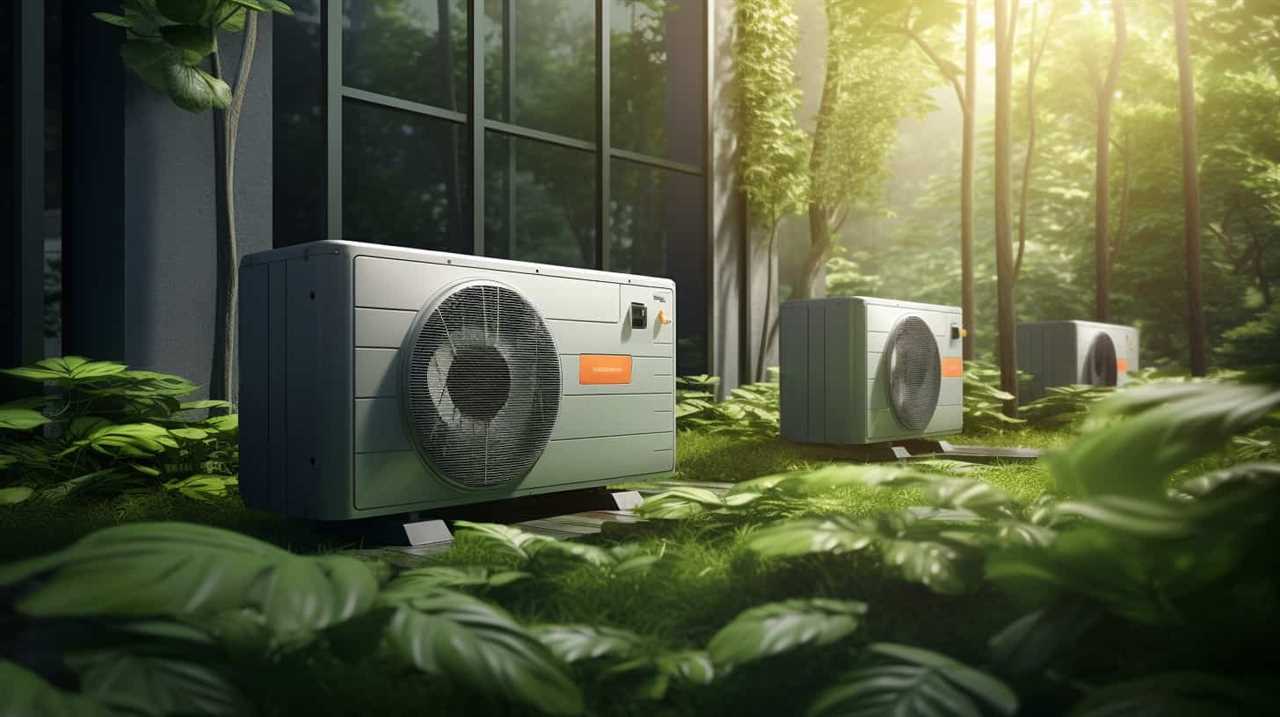
Additionally, proper ventilation helps remove any fumes or gases produced during the installation process, ensuring a healthy and comfortable living environment.
Electrical Requirements and Safety Considerations
When it comes to residential heat pump installation, proper wiring installation is crucial for the system to function efficiently and safely. We must ensure that the electrical requirements, including the voltage and amperage ratings, are met to prevent any damage or malfunctions.
Additionally, grounding and bonding requirements must be followed to protect against electrical shock hazards. Throughout the installation process, it’s essential to prioritize safety precautions and adhere to industry standards to ensure a successful and secure installation.
Proper Wiring Installation
First, ensure that the electrical requirements are met and take necessary safety considerations into account during the proper wiring installation for your residential heat pump.

Here are three important factors to consider when it comes to wiring techniques and safety measures:
-
Gauge selection: It’s crucial to choose the correct gauge wire for your heat pump installation. The gauge determines the amount of electrical current the wire can handle. Using an undersized wire can lead to overheating and potential fire hazards. Refer to the manufacturer’s guidelines or consult with a professional to determine the appropriate gauge for your specific heat pump model.
-
Proper grounding: Grounding is essential for electrical safety. Make sure to connect the heat pump’s electrical components to a grounding wire that’s securely connected to a grounding rod or the main electrical panel. This helps to prevent electric shocks and protects against electrical faults.
-
Junction box installation: Use a junction box to safely enclose all connections and wiring splices. This not only provides a neat and organized installation but also protects the wiring from accidental damage and minimizes the risk of electrical hazards.
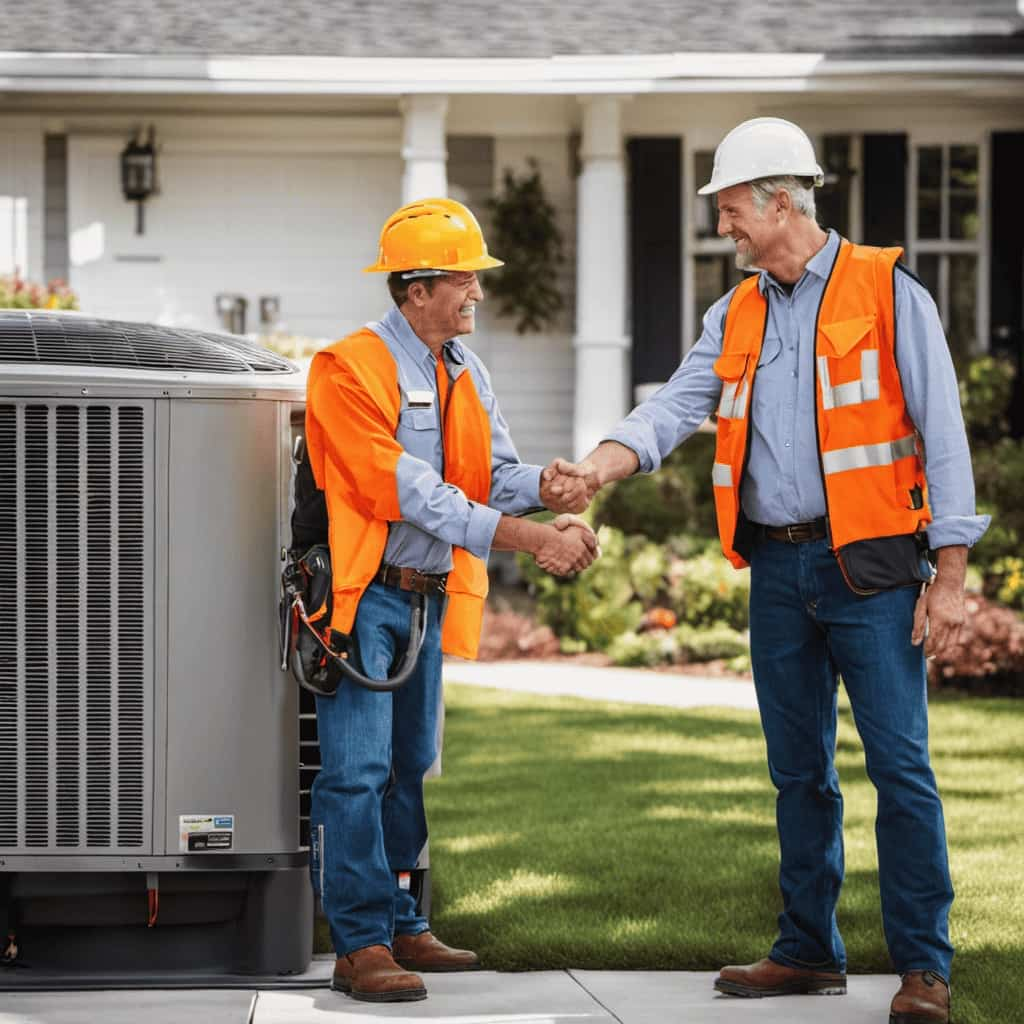
Grounding and Bonding Requirements
For our residential heat pump installation, we need to ensure proper grounding and bonding requirements are met for electrical safety considerations. Electrical grounding and bonding techniques are essential to protect against electrical shock and ensure the safe operation of the heat pump system. Grounding provides a direct path for electrical current to flow into the ground, while bonding connects all metal components of the system to prevent the formation of hazardous electrical potential differences.
To illustrate the importance of grounding and bonding, consider the following table:
| Component | Grounding | Bonding |
|---|---|---|
| Heat Pump Unit | Grounded to earth using a grounding electrode system | Bonded to all metal components using conductive bonding jumpers |
| Electrical Panel | Grounded to earth using a grounding electrode system | Bonded to all metal components using conductive bonding jumpers |
| Supply Lines | Grounded using grounding conductors | Bonded to all metal components using conductive bonding jumpers |
Safety Precautions During Installation
To ensure the utmost safety during the installation process, we must adhere to specific electrical requirements and carefully consider safety precautions. Here are three important safety measures to take during heat pump installation:
-
Use proper safety gear: It’s essential to wear the right protective equipment to minimize the risk of injury. This includes safety glasses, gloves, and non-conductive footwear. Additionally, insulated tools should be used to prevent electrical shocks.

-
Follow the installation process carefully: It’s crucial to strictly adhere to the manufacturer’s instructions and guidelines provided in the heat pump installation manual. This ensures that the system is installed correctly and reduces the likelihood of accidents or malfunctions.
-
Disconnect power supply: Before starting the installation, always disconnect the power supply to the area where the heat pump is being installed. This prevents accidental electric shocks and protects both the installer and the equipment.
Following these safety precautions will help ensure a safe and successful heat pump installation.
Proper Refrigerant Charging and Piping Installation
We recommend following these three essential steps for proper refrigerant charging and piping installation.

First, it’s crucial to adhere to the manufacturer’s guidelines and specifications for refrigerant charging techniques. This ensures that the correct amount of refrigerant is added to the system, preventing performance issues and potential damage. Proper refrigerant charging also contributes to energy efficiency and system longevity.
Second, piping installation best practices should be followed to ensure optimal performance and reliability. This includes proper sizing, insulation, and routing of the pipes to minimize pressure drop and heat loss. It’s important to use high-quality materials and techniques to prevent leaks and ensure the longevity of the system.
Lastly, regular maintenance and inspections should be conducted to check for any refrigerant leaks or piping issues, allowing for timely repairs and preventing further damage. By following these steps, you can ensure a properly functioning heat pump system for your residential property.
Setting Up and Programming the Thermostat
Let’s begin by understanding the process of setting up and programming the thermostat for optimal heat pump performance. Proper programming techniques can significantly improve energy efficiency and comfort in your home.

Here are three essential steps to follow:
-
Select the appropriate program: Choose a program that aligns with your daily routine. For example, if you work during the day, set the thermostat to lower temperatures when you’re away and raise it before you return.
-
Set temperature differentials: The temperature differential is the range within which the thermostat cycles the heat pump on and off. It’s crucial to set this differential correctly to prevent frequent cycling, which can reduce efficiency and increase wear and tear on the system.
-
Troubleshoot thermostat issues: If you encounter any problems with your thermostat, such as incorrect temperature readings or unresponsive controls, check the user manual for troubleshooting tips. If the issue persists, it’s best to contact a professional technician for assistance.

Regular Maintenance and Troubleshooting Tips
Regular maintenance is essential, but troubleshooting tips are equally important for ensuring the optimal performance of your residential heat pump. By regularly maintaining your heat pump, you can prevent major issues and keep it running smoothly. Here are some important regular maintenance tasks you should perform:
-
Clean or replace air filters: Dirty filters can reduce airflow and strain the system, so make sure to clean or replace them regularly.
-
Check and clean the outdoor unit: Remove any debris or obstructions around the outdoor unit and clean the coils to ensure efficient operation.
-
Inspect and clean the indoor unit: Check for dust or debris in the indoor unit and clean it as necessary.
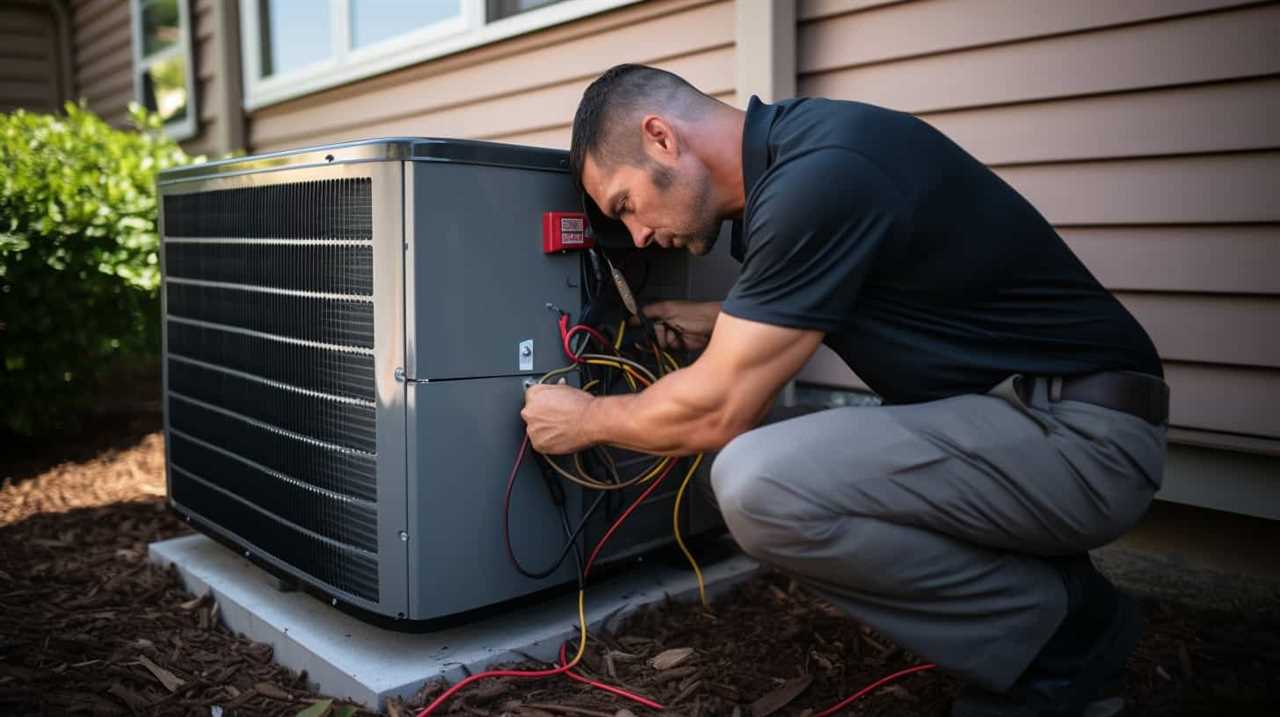
-
Schedule professional maintenance: Regularly have a professional technician inspect and service your heat pump to identify any potential issues and ensure optimal performance.
When it comes to troubleshooting techniques, here are a few common problems and their potential solutions:
| Problem | Solution |
|---|---|
| Heat pump not turning on | Check the power supply, thermostat settings, and circuit breakers. |
| Insufficient heating or cooling | Clean or replace air filters, check for blocked vents or registers, and ensure proper thermostat settings. |
| Strange noises or vibrations | Inspect the unit for loose or damaged components and contact a professional technician if necessary. |
| Heat pump freezing up | Check for dirty air filters, low refrigerant levels, or blocked airflow. |
Regular maintenance and troubleshooting techniques are vital for keeping your residential heat pump in excellent condition. By following these tips and addressing any issues promptly, you can ensure the efficient and reliable operation of your heat pump throughout the year.
Frequently Asked Questions
How Much Does a Residential Heat Pump Installation Typically Cost?
Typically, the cost of residential heat pump installation depends on various factors such as the size of the unit, the complexity of the installation, and any additional equipment or upgrades needed. Installation considerations play a crucial role in determining the overall cost.

How Long Does the Installation Process Usually Take?
The installation process for a residential heat pump typically takes around 1-3 days. Our team of experts will guide you through the installation time frame and provide detailed process details to ensure a smooth and efficient experience.
Are There Any Government Incentives or Rebates Available for Installing a Heat Pump?
Yes, there are government incentives and rebates available for heat pump installation. They provide financial assistance and cost savings. The installation time is reasonable, and heat pumps are compatible with existing systems, even in older homes.
What Are the Potential Energy Savings I Can Expect From a Heat Pump Installation?
Potential energy savings from a heat pump installation depend on factors like climate, insulation, and usage patterns. By efficiently transferring heat, a heat pump can significantly reduce energy consumption and save you money on heating and cooling costs.
Can a Heat Pump Be Installed in an Older Home With an Existing Heating System?
Yes, a heat pump can be installed in an older home with an existing heating system. It offers benefits like energy efficiency and cost savings. We have experience installing heat pumps in both new construction and older homes with great success.

Conclusion
In conclusion, the installation of a residential heat pump requires careful consideration and attention to detail. By selecting the right heat pump, ensuring proper sizing and load calculation, choosing a suitable location, and following electrical and safety guidelines, homeowners can enjoy efficient and reliable heating and cooling.
Just like a well-tuned engine powers a smooth ride, a properly installed heat pump can be the engine that drives comfort in your home.









